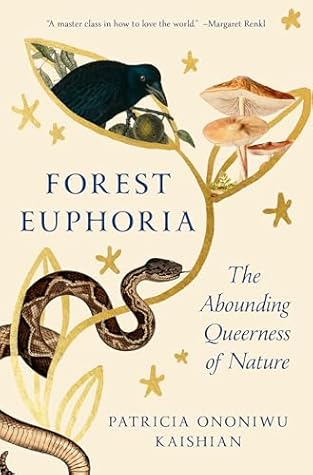More on this book
Community
Kindle Notes & Highlights
Ironically, it is in this very bleak landscape that I have found a trace of hope. This feeling is rooted in a reverence for postapocalyptic beings, especially those ripped from ancestral homelands: Who am I to despair when my ancestors and the ancestors of my loved ones fought so hard to survive? Who am I to resign myself to some abstracted “end of times,” when people have been struggling against colonialism and genocide for hundreds of years?
I have no intention of ever rejoining the church—if they would even have me—but I do like to think about what I can forage from this world that used to be mine.
I like to imagine a love story told in the language of microbiomes. First, you meet someone. You like their scent. You kiss and cuddle. You spend more and more time together, sharing meals, a bed, and physical space. You live together, constantly exchanging populations of microbes. Eventually—over the course of years, perhaps—you arrive at a jiving equilibrium, inhabited by what was once part of your lover while maintaining a bit of difference. You change each other; it’s kinetic. Then, maybe, someone leaves or dies. Your respective microbe populations are no longer in conversation. Gradually,
...more
But they also share a quality that is extraordinarily common in human endeavors the world over and since the beginning of historical records: loneliness. The exploration of outer space, and particularly the search for extraterrestrial life, is in large part driven by our desire to feel a reciprocated connection with the universe. We don’t just want to sense; we want to be sensed. We don’t just want to find life; we want to find intelligent life. We want to be spoken to.
I was hoping someone else, some romantic partner, would be a person they were not. I was hoping they would, in a way, be me. That they would do the deep, loving work only I can do for myself.
Like hearing a song for the first time and feeling, paradoxically, that it is singularly for you—and that it was created by someone who is, in some way, just like you. You cannot manufacture that feeling. It simply happens.
Darwin began to see these changes as the flickering evidence of desire, of pleasure, in the long chronicle of natural selection. While he, however, was keen to recognize not only the possibility but the likelihood that other species appreciate arbitrary beauty—and that it impacts both their decision to mate and the evolutionary record—some contemporaries and successors found the idea to be improbable if not fully absurd. That other species could both perceive and prefer beauty apart from the machinations of natural selection was rejected on two counts: one, that only humans were capable of
...more
Desire is activated by the sensations of being alive—the way a fish scale refracts photons in the dappled light of a kelp forest, the sight of a túngara frog’s throat inflating during song, a whiff of deer musk. Preferences are intrinsic and often latent, meaning that an animal may not know she has one until the moment she experiences it.
The forces of evolution do not move in any predetermined direction.
When you realize other species experience desire and pleasure, things you may have thought were only for humans, the world becomes infinitely more beautiful. When you learn that asters and goldenrod look so lovely next to one another because their purple and golden petals appear more vivid side by side—because the pollinator finds this lovely and eye-catching, too—you feel less alone. When you see how a bowerbird spends years of his life artistically arranging his home to attract love, you can more easily see yourself as part of a long, sprawling story on this earth.
Eels may be born with a magnetic memory—similar to how human fingerprints form as we press the pads against the lining of our mothers’ wombs, imprinting them with the soft contours of their internal space. The variable dynamics of the ocean, the gravitational push and pull of the tides, the relational masses of the moon and Earth and its iron heart are the topographies etched into crystals and passed down generationally.
I would never stop missing my birth habitat. I think often about what Robin Wall Kimmerer describes as “becoming indigenous to place”—to intentionally and intensively bond to an ecology, to be a steward and a student of the species around you, regardless of your ancestral origins. After you establish such a bond, how could you ever say goodbye?
Over the course of my life, I have explored multiple meditative and energetic practices. As someone with ADHD and as a survivor of trauma, anything that insists on total stillness accompanied by total silence is not suitable for me. It feels torturous. I need movement and I need ambient sound. It took me years to realize that a practice of immobile meditation is not something I should force on myself, that it is simply one tool out of many. I am continuing to learn how to empower my own body, to be loving and protective, to honor my needs. I am practicing not being so hard on myself—I can’t
...more
When queerness is perceived as cool, others will want a piece of the pie. What was edgy, provocative, and daring is co-opted, and so we get used to staying a few steps ahead and saying goodbye. Much like mushrooms or spring ephemerals, the most memorable and special queer spaces—I prize the memory of “Dreamland,” a series of Syracuse dance parties I attended in my midtwenties—are those that last only a couple sessions, months, or years, existing as a glimmering moment in time, before retreating out of sight, rearranging themselves, and emerging elsewhere when the season is just right.


